|
|
Sorcerer

|
|
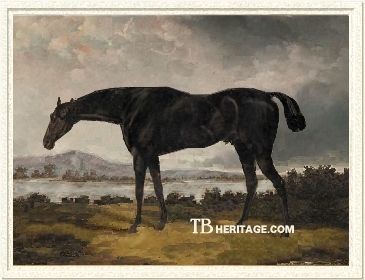 |
|
|
Sorcerer was a good race horse and a popular and influential sire who got seven classic winners, and was the conduit through which the Godolphin Arabian sire line continued.
His sire, TRUMPATOR, was a black colt of 1782, out of the Squirrel mare, Brunette. Trumpator was bred by William Henry Fortescue, 1st Earl of Clermont (1722 - 1806), who derived a solid fortune from estates in Ireland and who had a great deal of influence in the Irish Parliament, where he was a M.P. for the town of Monaghan, and where he later served as Paymaster General for Ireland and Governor of County Monaghan. In 1770 he was elevated to the peerage as Baron Clermont. Clermont was an accomplished courtier, an intimate of the French royal family at Versailles and also of George, Prince of Wales. He lived at Clermont House in London and at his estate, Clermont Lodge, Little Cressingham, near Waton, Norfolk, situated on a vast amount of acreage and formal gardens. He was one of the founding members of the Jockey Club, along with his peers and associates, the Duke of Cumberland, the Earl of Barrymore, and the Duke of Grafton, all prominent figures in the Regency period of England. With all his influence at court, it was no surprise he was raised to an earl in 1777.
Clermont had an interest, along with another associate, a fellow Irish-based peer, Robert Maxwell, (1st) Earl of Farnham of County Cavan, in the best of Matchem's sons, the chestnut CONDUCTOR, the sire of Trumpator. In addition to Conductor, Clermont owned a number of other top race horses of the period, many of them sons and daughters of Matchem and of Marske -- his mare, the grey Masquerade (1771), by Marske, was one of the fastest and best horses of her day, beating most of the best and earning £5,716 for Clermont. Among Clermont's better runners was Mark Anthony, who sired the 1785 Derby winner Aimwell for Clermont. He also owned the Oaks winner of 1785, Trifle, and the first and second place finishers in the 1792 Oaks, the Highflyer daughter Volante and Trumpetta, a daughter of Trumpator.
Trumpator's dam, Brunette (1771), had been bred by the Earl of Farnham, who died in 1779. In Clermont's ownership, beginning in 1779, she produced eleven foals for him, all of them either by Conductor or his son Imperator (1778, from a Herod mare), the latter also bred by Clermont. Trumpator and his half-brother, Pipator (1786, by Imperator), later sire of the good stayer and St. Leger winner, Remembrancer , were her best.
Trumpator, her third foal, grew to a height of 15.2 hands, and in addition to his size and substance, he had a lot of speed. He won eight races in three years on the turf, including the Prince's Stakes, the Clermont Stakes, the Claret Stakes and some matches against good horses, and collected forfeits for several matches, almost all at Newmarket. He stood his first few seasons in Newmarket, and at Chippenham,1788 - 1803, but later spent a few years in service at Clermont Lodge; after that, in 1806, he stood at Rockingham Castle in Northamptonshire; when he died, on May 7, 1808, at Newmarket, he was buried, fittingly, on the Clermont Course there. A leading sire in 1803, he got a Derby winner in his son, DIDELOT (1793). His daughter PENELOPE (1798, Family 1), bred by the Duke of Grafton, ran and won for five years in top company, and in the stud produced the influential stallion Whalebone (1807), several classic winners, and a number of influential daughters. Penelope's full sister, PAWN was the dam of two classic winners. Trumpator's son, PAYNATOR (1791, from a Mark Anthony mare), was also bred by Clermont, and in the stud his son, the good Northern runner Dr. Syntax (1811) who won 32 races, sired two classic winners and two Doncaster Cup winners, including the great race mare Beeswing. Paynator's sister, Miss Furey, was accorded her own branch of Family 18 (18 - a).
Sorcerer's dam was a bay daughter of Derby winner Diomed called YOUNG GIANTESS, who was bred by Sir Charles Bunbury (1740-1821) in 1790 from the Matchem mare, Giantess (1769). Bunbury, (6th) Baronet was M.P. for forty years for Suffolk, where his family had large estates, and where, at Barton Hall, Great Barton, he bred racehorses for much of his life. He was co-founder, with the 12th Earl of Derby of the Derby Stakes at Epsom, and won the first running of it with a horse he bought as a yearling or two year old, the chestnut Diomed; he won it again in 1801 with the great race mare Eleanor, and a third time with Smolensko, a son of Sorcerer, in 1813. Bunbury later sold Diomed, age 21, to the U.S., where he became one of the most influential sires of the American turf. Bunbury was named a steward of the Jockey Club at age 28, and rose to become its most influential member. He was popularly known as "the Dictator of the Turf," first of three men who carried that appellation over the years. He is credited with two significant innovations--the emphasis on juvenile racing and consequently precocity, and shortening distances in races, of which the Derby was an example.
Young Giantess ran twice, unsuccessfully, at the age of three, and was then retired to Bunbury's stud, where she bred nine live foals, dying in 1811 when foaling twins. She was an extremely influential broodmare, and a good producer. Other than Sorcerer, her first foal, she produced Eleanor (1798, by Whiskey), the aformentioned winner of the Derby -- and also the Oaks --who produced the sire Muley (1810, by Orville) in the stud, sire of Derby winner Little Wonder (1837), Oaks winner Vespa (1830), St. Leger winner Margrave (1829), Leviathan (1823), a five-time leading sire in the U.S.,and Muley Moloch (1830), the latter the sire of Alice Hawthorn. Her next foal, Julia (1799, by Whisky), was the dam of Derby winner and top broodmare sire Phantom (1808). Her daughter Cressida (1807, by Whiskey), was the dam of 2,000 Guineas winner Antar and Derby winner Priam, who was an important sire both in England and in the U.S. At age 18 she produced an unnamed filly to Walton, who became dam of Langar, a fast horse who sired a top flyer and winner of twelve races, Vulture, the dam of Orlando.
Sorcerer was Young Giantess's first foal, born in 1796 at Bunbury's Great Barton estate; because his grandam, Giantess, was a daughter of Matchem, he was in-bred 3 x 3 to Matchem. A good-tempered horse, he grew to a height of 16. 1-1/4 hands, and was described as a horse of "great size and substance," apparently inherited from Babraham, a son of the Godolphin Arabian and the sire of his third dam, Molly Long-Legs.
Sorcerer on the Turf
Sorcerer was a good race horse, although not in the top tier of his generation. He won at distances from five furlongs to four and one-half miles, and during the process did beat some previous classic winners. He "stood his work well," and was never sidelined for soundness issues.
In 1799, his three year old year, Sorcerer ran twice at Newmarket, placing second to the Volunteer son, Eagle, in a sweepstakes, and then winning a match for 100 guineas over the Two Year Old Course, beating Royala, a Trumpator filly owned by Lord Clermont.
At age 4 he started the season by losing a 200 guineas match to Schedoni, a Pot-8-Os colt a year older than he. He then won two matches at Newmarket, first against the Trumpator colt, Chippenham, and then against the five-year-old Dragon colt, Speculator. He followed that by winning a King's Plate at Ipswich, beating two horses, and then a race over the Ditch-In course at Newmarket, beating three colts.
|
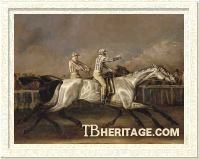
Symmetry beating Sorcerer at Newmarket in a famous match
| |
In the fall, the frequency of his races was stepped up. At Newmarket, he lost a 500 guineas match to the 5 year old Doncaster St. Leger winner, Symmetry, and then ran third in a six horse race won by a Precipitate colt, Humbug. He ran second in his next race, a King's Plate at Newmarket, won by a Pot-8-Os son, Worthy, but he beat Humbug, who ran third. He finished the season with two wins: a 200 guineas match at Newmarket over the Ditch-In course, beating a Buzzard colt, Surprise, and the October Oatlands handicap, beating eight horses.
|
In 1801, his last year on the turf, he won £50 in a race at Newmarket Craven, beating John Bull, and also a Newmarket Spring, another race in which he beat the 1798 Derby winner Sir Harry, who had run second to his third the previous year at Newmarket. He also collected a 50 guineas forfeit from the Walnut son, Richmond. These wins were followed by a King's Plate race at Newmarket, in which he placed second to Worthy again. He then met Richmond in a 100 guineas match over two miles, which he won, and in July at Newmarket, won another 200 guineas in a second match against Richmond, followed the next day by a walk-over for a £50 purse. Two weeks later, at Oxford, he won £50 in a race against Cordovan in three-mile heats., and after that, also at Oxford, had a walk-over for the King's Plate. The last race of his career was a win of a sweepstakes at Lewes over four miles.
Sorcerer at Stud
Sorcerer was a highly successful stallion for Bunbury, one of the most celebrated stallions of his time. He got seven classic-winning offspring -- four colts and three fillies -- and a number of other very good youngsters. Several of his sons initially promised a continuation of the Godolphin Arabian sire line -- three of his classic winning sons themselves sired classic winners. But in the end, it was one of his more moderate racing sons, Comus, who sent the line forward, again, not through one of his own classic winning sons, but through another lesser racing son, Humphrey Clinker. One of Sorcerer's best colts, Truffle, although not a classic winner, had an influence on French breeding when exported to that country. Four of Sorcerer's daughers produced classic winners, and more than a few head their own branches of various female family lines. He frequently passed on his size, good bone, soundness, and speed to his youngsters. Sorcerer died in 1821, age 25.
|
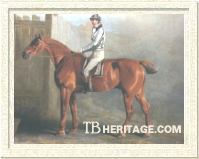
Soothsayer
| |
A chestnut colt bred by Richard Gascoigne, SOOTHSAYER was born in 1808 from Goldenlocks, a Delpini mare bred by Sir Thomas Gascoigne in 1793. Goldenlock's dam was the Shark mare, Violet, who was a terrific producer, having got Sir Thomas' St. Leger winner Symmetry, his Oaks winner Theophania, and four other good runners, not all by the same sire. Like most Sorcerers, Soothsayer was tall, with excellent bone and power hindquarters.
|
Soothsayer was started at age 3 in the Peregrine Stakes, in which he placed second to a colt by Hambletonian. He won his next race, the Doncaster St. Leger, beating a field of twenty-seven, including the favored Magic, also by Sorcerer, who had placed second in the Derby, but ran fourth in this race. Soothsayer was sold after the St. Leger to Lord Thomas Foley, for whom he finished the season by winning the Doncaster Stakes.
At age four his form slipped: he won a sweepstakes for four year old colts at Newmarket, but followed that by paying a forfeit in a match for 200 guineas against the good Orville filly, Elizabeth. His next and last race as a four year old was an ignominous third and last to the Sorcerer filly, Sorcery, and a very moderate colt by Sorcerer called Bethlem-Gaber. In 1813, his last season, he ran once, beating the 1811 Derby winner Phantom in a match for 500 guineas: it was the first and only time they met. After that, he was retired to stud.
Soothsayer was a successful stallion who led the sire lists in England in 1819: he got two classic winners, Interpreter, who won the 2,000 Guineas in 1818, and Tiresias, who won the Derby the following year, as well as the Newmarket Stakes and the Palace Stakes. A Soothsayer daughter, Miracle, won the July Stakes at Newmarket. He had over eighty winners in his nine years at stud in England, and got some very good producing daughters, including Filagree (1815, from Web, Family 1 - s), the dam of Cobweb (Oaks and 1,000 Guineas, and dam herself of three classic winners) and Riddlesworth (2,000 Guineas); Katherine, dam of Tarantella, who won the 1,000 Guineas and later produced two winners of French classic races; Marinella, dam of Ascot Gold Cup winner Leopold, and a daughter who had good winners in England and Germany. Soothsayer was sold to Russia in 1823.
|
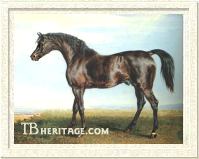
Smolensko
| |
The black SMOLENSKO was one of Sorcerer's most successful racing son. He was bred by Sir Charles Bunbury. Smolensko, born in 1810, was his second Derby winner. Smolensko was out of a Mentor mare, Wowski, who, in 1806, had produced his full brother, also black, THUNDERBOLT (see below). He was much admired for his looks, graceful and powerful action, and his calm demeanor. Through his St. Leger winning son, Jerry (1821), Smolensko established a sire line that extended several generations before petering out.
|
Smolensko debuted in the 2,000 Guineas at Newmarket, which he won, beating Oaks winner Music, Phosphor, and nine others. He followed that by winning the Newmarket Stakes, and then the Derby against a modest field, which prompted a great deal of wagering, and the excitement of the race extended into the crowd of spectators, where a number of accidents erupted after the running. Smolensko followed his easy win in the Derby by winning the Magna Charta Stakes at Egham. In October at Newmarket he ran last in a sweepstakes, spraining a hind leg in the running; because he wasn't sound enough to run, he paid forfeith to Benedict in a scheduled match. He was back in shape in time for Newmarket, Houghton, and won a 200 guineas match against Redmond.
In 1814, age 4, he won the two races he entered: a 200 guineas match against Tiger, who had won the Peregrine Stakes, and a handicap sweepstakes at Newmarket First Spring, carrying the heaviest weight, against four other four year olds. That was his last race, and he retired to the stud.
Smolensko sired two classic winners -- Jerry, and daughter Gulnare (1824, Oaks winner). He also got Doncaster Cup winner Retriever. Smolensko's son Banker (1816), ran for five years, and counted among his wins the Swimley Stakes, the Claret Stakes, the Oatlands handicap, the Newmarket Trial Stakes, the Ascot Gold Cup (walk-over), the Winchester Cup, the Gold Cup at Abingdon, and a number of other matches and sweepstakes.
Smolensko's son, Jerry, a horse of "remarkable size and substance," won the St. Leger, and got Clearwell, who won the 2,000 Guineas. Another Jerry son, Tomboy (1829), who won the Doncaster Cup, sired the good racehorse Nutwith (1840), who won the St. Leger. Nutwith was grandsire, through Knight of Kars, of The Colonel (1863), who won the Aintree Grand National twice, in 1869 and 1870; New Oswesty, another Knight of Kars son, was a winner on the flat and over fences, and the sire of one of the few mares to win the Grand National, Zoedone (winner in 1883). Another Jerry son, Jericho (1842), sired 2,000 Guineas winner The Promised Land (1856), but died early in his stud career.
Many of Smolensko's daughters bred on. Among the more notable are: Fawn (1823) the dam of the good race horse Venison (1833), by Partisan; his Oaks winning daughter, Gulnare, who produced 2,000 Guineas winner The Corsair; Ina, second dam of two good horses, The Cur (1842, by Bran), and The Prime Warden (1834, by Cadland); Wilna (1815), third dam of St. Leger winner Saucebox (1852); an unnamed daughter (1828) from Miss Chance, who was the dam of Loutherberg, a multiple stakes winner by Mameluke; another unnamed daughter who was the dam of Royal Oak (1823), a very influential sire in France, and she was tail-female ancestress of a host of good winners, including Oaks winner Airs and Graces and French stakes winner Jardy; yet another unnamed daughter (1818) was second dam of Catton daughter Galopade (1828), dam of the Glencoe daughter Reel, and therefore tail-female ancestress of all her descendants in the U.S.A, such as Domino, Hamburg, Affirmed, and Winning Colors.
|
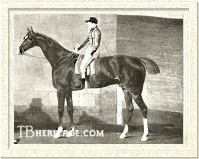
Wizard
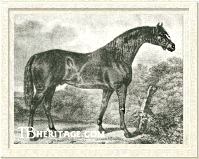
Thunderbolt
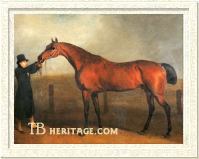
Truffle
| |
WIZARD was a flashy chestnut colt born in 1806 from a mare by Precipitate. He was owned by Christopher Wilson, later known as the "Father of the Turf," a Yorkshireman respected for his honesty and staunch support of the Jockey Club. Wilson had been the owner of Champion, the first horse to win both the Derby and the St. Leger, in 1800 ( a feat not repeated until Surplice in 1848), and Charlotte, the first winner of the 1,000 Guineas, in 1814. Wizard, likewise was a "first," winner of the inaugural running of the 2,000 Guineas in 1809. He ran second to (Waxy) Pope in the Derby, beating eight others. Among his other races, including a forfeit from Whalebone in 1811, Wizard trounced Pope, while giving him 3 pounds, in a 200 guineas match at Newmarket in the fall of 1809. He died young, in 1813.
THUNDERBOLT was a black colt born in 1806, out of Wowski, and so a full brother to SMOLENSKO. He was, like Smolensko, bred by Sir Charles Bunbury, and also like him, over 16 hands tall, with excellent bone. He was fast and powerful. Bunbury, fond as he was of his good Sorcerer colts and their racing successes, turned down an offer of £2,000 for Thunderbolt after a successful spring season, his first, at age three, at Newmarket. He had won the 475 guineas Newmarket (July) Stakes, and a 50 sovereign race for three year old colts, beating some good youngsters. He also received forfeits in two races, both from Trumpator offspring--the filly Mirth, and the colt, Trump. Thunderbolt seriously injured his fetlock joint in a stable accident, terminating his turf career before he could finish the season. He good some good runners, but no classic winners.
TRUFFLE was a bay colt out of Hornby Lass (Family 1), by Buzzard, who two years earlier had produced his full sister, MOREL, destined to win the Oaks and other good races for the 4th Duke of Grafton (see below). Hornby Lass was a daughter of the great broodmare Puzzle, by Matchem, and so both Truffle and Morel were linebred to Matchem via both sire and dam.
|
Bred at the Grafton Euston stud, Truffle was sold to Colonel Udney, for whom he ran for four years, ages 3 to 6, with some success.
At age three, Truffle won four races, and received a forfeit in a fifth; he lost only once, to Phantom, in a 200 guineas match at Newmarket, and he beat some very good horses that year, including 1809 Derby winner Pope (Waxy-Pope).
At age four, he ran second in the two-mile Port Stakes at Newmarket, but won or received compromises in four matches against some good horses. In his only other race that year he ran third in a sweepstakes at Newmarket, won by Rainbow, with the Sorcerer filly Sorcery (1811 Oaks winner) placing second.
In 1813, age 5, he won a 300 guineas match against Benedict, a 300 guineas match against Eccleston, and a 300 guineas match against Offa's Dyke. He also, at Newmarket, won a two mile sweepstakes, beating another Sorcerer son, Magic, and a sweep of 400 guineas, beating three horses, including the Oatlands winner Mantidamum. He lost just once that year. In 1814 he won a 200 guineas match against that intrepid filly Sorcery, and received compromises in two separate matches against Merry-go-round; he did not place in the Craven Stakes, and he lost two other races that year, his final season.
He was retired to stud in England, but was sold by Colonel Udney, in 1817, to Antoine-Agenor-Heraclius de Gramont, the duc de Guiche, a Bourbon intimate, who, a few years after the Restoration in France, went to England with the express purpose of purchasing thoroughbreds to reinvigorate the lines that had not seen much in the way of new blood since Napolean had taken power. As head of the royal stud in Manche, the Haras de Meudon, he purchased Truffle in 1817 for this purpose, and two years later bought another stallion in England, the grey Rowlston, a Camillus son. Both stallions were bred to a selection of fourteen thoroughbred mares. The experiments at Meudon were successful, and influenced the direction of a number of stud farms throughout the country -- La Source, la Roche, Viroflay (where Rainbow later held court), Celle-Saint-Cloud, Guerres, and elsewhere. The duc de Guiche was only able to enjoy a few years of success with the bloodstock he bred at Meudon, losing his position with the second revolution and the installation of the Orleans regime in 1830.
The most important race in France in the early 19th century was established in 1806 as an autmun fixture at Champ-de-Mars, Versailles; it was initially called the Grand Prix, and by 1834, the Grand Prix Royal (later it went by several other names, ultimately the Prix Gladiateur). The names of the early winners of this race are lost, but by 1817 imported horses, and then horses by imported sires began to win the event, which was held over 4,000 meters. Medea, an 1823 Truffle filly out of Crystal, won the event for the Duc de Guiche in 1827. Another Truffle daughter in France, Vanda (1827), became the dam of Vorok, who won the Prix du Jockey Club (French Derby) and Prix du Cadran. Truffle was sold to an English citizen for 1,000 guineas in 1827, age 20, and he was shipped back to England.
Before crossing the channel to France in the teens, he got Abjer (1817), whose only loss during two years on the turf was a second place in the Derby and who later sired a couple of influential daughters. In England Truffle also sired son Champignon (1816), who won the Ascot Gold Cup, and Fungus (1816), who was a good winner.
|
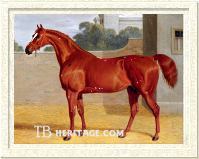
Comus
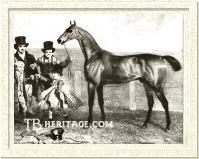
Bourbon
| |
COMUS, a temperamental chesnut with white and dark spots scattered throughout his coat, was the Sorcerer son through whom the Godolphin Arabian line survived. He was born 1809, out of the Sir Peter daughter, Houghton Lass, who had been a decent race mare. Comus was a fairly moderate horse on the turf, but he could win at distances from five furlongs to two miles. In the stud he was succcessful, siring four classic winners: two classic-winning sons, and two daughters, the 1,000 Guineas winner Catgut, and the great staying mare Matilda, who won the St. Leger. The son who continued the Godolphin Arabian line was Humphrey Clinnker, an even more modest racehorse than his sire, although he won at 4 miles, and he inherited his sire's temper, as well as introducing an unsoundness in the wind which plagued future descendants, including his son, Melbourne, twice leading sire in England, through whom the sire line continued.
BOURBON, a bay of 1811, by Sorcerer, out of a Precipitate mare, was a sturdy colt that ran for four years, accumulating 5,015 guineas. He won, among other races, the Oatlands, the Claret Stakes, The Craven Stakes, and the Trial Stakes. He sired the staying mare, Doncaster Cup winner Fleur de Lis, and a good race horse in Alderman; their dams were the only mares sent to him his only season at stud in England. |
He was sent to Russia in 1821. His grey unnamed sister of 1810 was the dam of St. Leger winner Jack Spigot.
TROPHONIUS was another black son of Sorcerer, out of a Dungannon daughter, foaled in 1808. He won the 2,000 Guineas and the Newmarket Stakes at age 3, but failed to place in Phantom's Derby.
Other Sorcerer sons of note include MAGIC, a chestnut of 1808, out of a Highflyer mare, who ran second to Phantom in the Derby, and placed second in the Northampton Gold Cup; his full sister, ELVE, was tail-female ancestress of a number of classic winners in South America. LOITERER (1806), won the Ascot Gold Cup. HOCUSPOCUS, a colt of 1810 owned by the Duke of Leeds, won a two mile match against the good colt Benedict (second in the St. Leger) for 200 guineas at Newmarket at age 3, and ran second and third in two succeeding years in the four mile Richmond Gold Cup, and running second to Whalebone in the 3-1/2 mile Northampton Gold Cup.
|
Sorcerer's Daughters
Sorcerer sired three Oaks winners -- Morel, Maid of Orleans, and Sorcery. Both Morel and Sorcery went on to produce classic winners themselves in the stud, and both, but Morel in particular, were influential tail-female ancestresses of many other good horses. Sorcerer got a good many other daughters, but none were especially successful on the turf, although more than a few produced winners of good races and were influential on the breed as a whole.
MOREL was bred by the (4th) Duke of Grafton in 1805. She was out of Hornby Lass (Family 1 - a), who also produced TRUFFLE, mentioned above. |
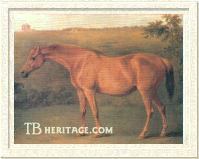
Morel
| |
Morel was a good three year old, winning the Newmarket (July) Stakes, the Oaks, the Three Year Old Stakes at Newmarket, two matches and a forfeit. At age four, all at Newmarket, Morel won the October Trial Stakes and a sweepstakes, matches against Beau Nash and against Clinker, and received a forfeit from Rubens. At age five, again at Newmarket, she won two matches, one against Nuncio, and the second a forfeit from Agnes; she also won the October Oatland Stakes and the Jade Stakes that year, and then was sold by the Duke to Robert Andrew. The following year, 1811, she won a match against Asmodeus at Newmarket, and she came out three times in 1812, age seven, but failed to place and was retired to stud. |
Morel was a good producer for the 4th Duke of Grafton, her two best were the good race filly Mangel-Wurzel, an 1823 daughter of Merlin, and her sister, the great producer Mustard, who produced two classic-winning offspring, Preserve (1832, by Emilius), who won the 1,000 Guineas and the Criterion Stakes, among other efforts, and her brother, MANGO (1834), who won the St. Leger and other races. Beginning in 1817, with a dead foal, Morel had trouble conceiving, missing to Scud two years in a row, before conceiving Mangel-Wurzel and Mustard in successive years. Missing to Merlin in 1824, she was sold at Tattersall's in 1825, age 20, for 8 guineas, the success of her two late daughters still in the future. She produced two more foals after that for Thomas Thornhill, squire of Riddlesworth, Norfolk, both by his Derby winner Sam.
The success of Morel's descendants were sufficient to merit her own branch of Family 1 (1 - b). Mangel-Wurzel was tail-female ancestress of a number of good winners in Europe and England--the great 1963 Hornbeam mare, La Milo, descends from her (dam of 1979 Derby winner TROY, of the very successful stakes-winning gelding Admetus, and of the good runner Tully).
Mustard, through success of descendants of Preserve, and her sister, Mangosteen, was also accorded her own family branch (1 - c); 1923 Oaks winner Brownhylda, St. Leger winners Firdaussi and Speculum, Derby winner and sire Spearmint, and such American classic winners as Arts and Letters and Pass Catcher descend from Preserve. From Mangosteen descend such horses as St. Leger winner Craig Millar, and Birkhan.
The unnamed 1926 Morel filly by Sam, born when Morel was 21, was tail-female ancestress of a host of stakes winners, including Aboyeur and Princequillo.
Sorcerer's daughter MAID OF ORLEANS was born in 1806, out of an unnamed Pot-8-Os daughter in the Wokingham, Berkshire, stud of General L. Gower. She won the Oaks of 1809, but apparently not much else. She produced eight foals in the stud, before being shot in 1825; of them, one was sent to Ireland, one to Germany, one to India, and one died at age 2. |
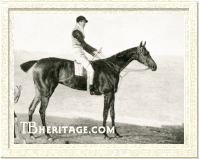
Sorcery
| |
SORCERY was the first foal of Cobbea, a Skyscraper daughter (Family 12); she was born in 1808 in the Duke of Rutland's stud. She was a good race filly who won the Oaks for the Duke in 1811, as well as the July Stakes and the Oatlands handicap, and at age four won the Oatlands again, and the Gold Cup at Epsom. At age five, she ran second to Octavius in the Epsom Gold Cup, her only race that year. She came back at age six to run second in a field of nineteen in the Craven Stakes, and she won a King's Plate over three miles at Newmarket. |
In the stud, she produced the brown colt Cadland (1825, by Andrew), who won the Derby and the 2,000 Guineas. Sorcery's full sister, WITCHERY (1814), was tail-female ancestress of a number of good winners, and a was fourth dam of May Bell, who heads her own branch of family 12 (12 - e). A number of excellent French and German stakes winners descend from her, including the great staying mare Ivanjica (1972, by Sir Ivor), who included the Prix de l'Arc de Triomphe among her many wins.
WITCH OF ENDOR (1807), a Sorcerer daughter from a Delpini mare, won the Newmarket (July) Stakes.
Other Sorcerer daughters not mentioned earlier that produced winners, or became especially influential in particular families were:
AGNES, 1805, from Highflyer daughter Amelia produced Chester Cup winner Grenadier.
CANARY BIRD, 1806, from Canary by Coriander, had two daughters by Selim, Quadrille(1815) and Varennes (1818), both of whom are important in Family 22. She also had a daughter by Pioneer, whose daughter, Echo has her own branch in this family (22 - b) and from whom descend a host of good winners, among them St. Frusquin and St. Gris. Innumerable stakes winners over the year have descended from Quadrille, among them dual-classic winners Tulyar and Trigo. Gladiator was a grandson of Quadrille's. English classic winners such as Mr. Jinks, Our Lassie, Mill Reef, half-brothers Manna and Sandwich from the good broodmare Waffles, and His Majesty, and Arc winner Parth and the good American filly Lady's Secret descend from Varennes.
The black GRAMARIE (Family 2), 1807, from a Sir Peter Mare, had a stakes winner in her son, Prince Leopold (1813, by Hedley), who won the Derby, and two daughters that bred on; one, a sister to Prince Leopold, Leopoldine, was tail-female ancestress of Bois Roussel and a number of other French classic winners; the other, Bella Donna (1818) was the dam of Derby winner Amato and ancestress of a number of good winners in tail-female descent.
LADY OF THE LAKE, 1809, from a Saltram mare produced a good filly, Ophelia (1831), who won the Woodcote Stakes and went on in the stud to produce a Royal Hunt Cup winner and some daughters who had stakes winners in Sweden, central Europe and Brazil.
PIQUET, 1810, out of the great Highflyer mare, Prunella, produced a July Stakes winner in her daughter, Loo (1815, by Waxy).
VOURNEEN, 1810, from Tooee, by Buzzard, produced July Stakes winner Reformer (1821), and a daughter, Mrs. Fry, who was second dam of The Wryneck, a mare who heads her own branch of Family 15.
DOLL TEARSHEET, 1813, from a Buzzard mare, was the dam of Goodwood cup winner Link Boy.
The black PYTHONESS, 1813, from the Sir Peter mare Princess, produced the good race mare Bobadilla, who won the Ascot Gold Cup. Bobadilla was the second dam of the Glencoe mare, Magnolia (1841), who heads her own branch of Family 4, with a great many American classic winners deriving from it.
--Patricia Erigero |
|
|
|

